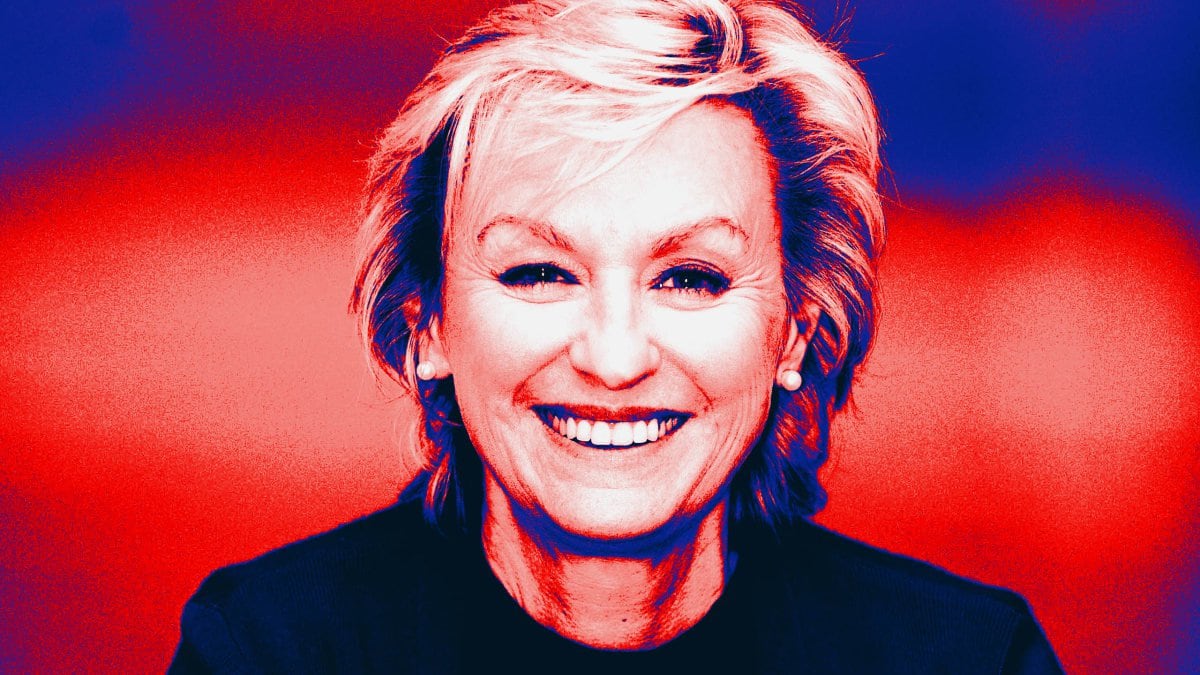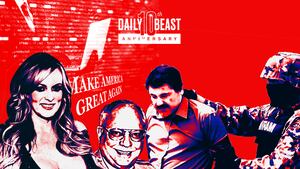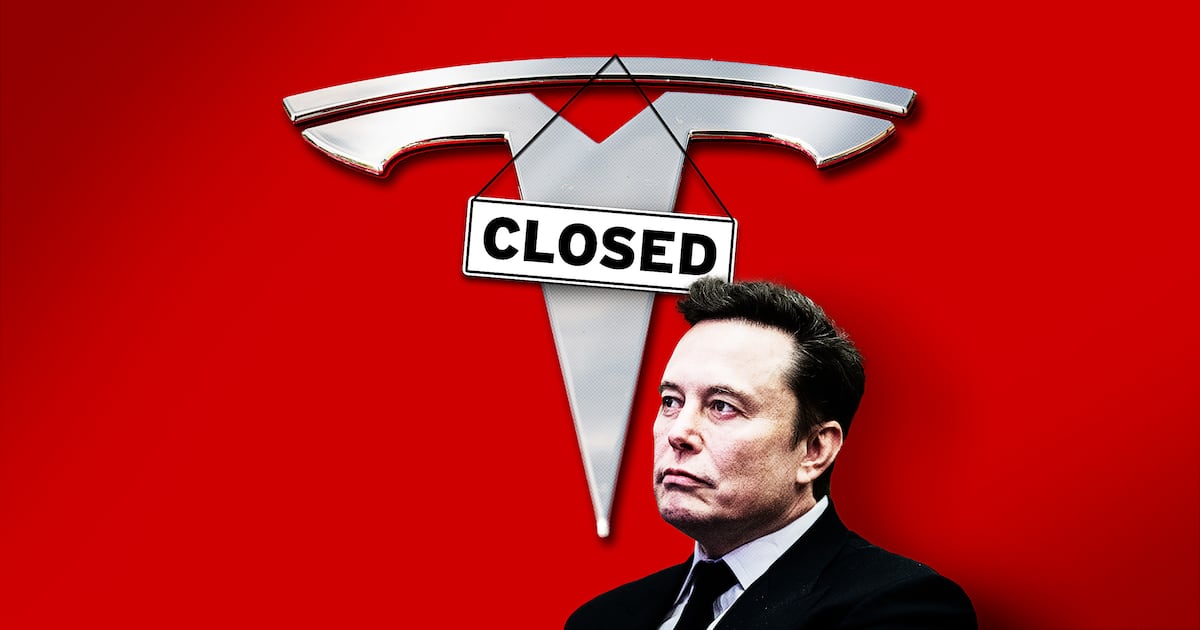The Daily Beast was born of a light heart. At the time I joined forces with Barry Diller’s IAC in 2007 to launch a new website, I was in the heady mood of having nothing much to lose. After all, I was coming off a mortifying chorus of tabloid schadenfreude after the belly flop of Talk magazine in 2002, but was starting to feel I had redeemed myself that year with a No.1 New York Times bestseller—The Diana Chronicles, my biography of Princess Di. As I soon learned, the best thing about failure is that it frees you up to stop worrying if you’re going to fail. You did and you rose again. Let’s party.
When Barry asked if I wanted to start an online news site, I immediately thought, no thanks. I was a print gal and had no interest in digital media. How could I forsake my love of long-form articles or the power of a beautifully photographed spread with a perfect headline for hot takes on politics and click-bait photo galleries? But as soon as I met with Brandon Ralph, the uber-cool visual genius behind the digital shop Code and Theory, I changed my tune.
In those days, the homepage was still king and news sites were mostly an arid wasteland of messy news links with zero sex appeal or personality. Brandon’s stylish mockups showed me that there was an opportunity to wed the visual glamour of a glossy magazine with the adrenaline of a 24-hour news cycle. And I soon saw that we could create a sensibility that combined tabloid raciness with sophisticated wit.
The Top Box, as we always referred to the upper left corner of the site, with its carousel of high and low stories, would be curated with the same care for the mix as an edition of Vanity Fair—a hard news story would be followed by something pop culture and glamorous, followed by some brainiac opinion piece followed by a gallery that went deep in the shallow end but was always entertaining.
Another of my early editorial obsessions was information overload. The Huffington Post, then in its prime, aggregated everything, but who had the time to read it all? I wanted to create a central column on the site that would list only 10 stories worthy of eyeballs and condense each of them to a pungent, attitude-loaded 150-word summary. And of course it had to be refreshed throughout the day. The Cheat Sheet—as it came to be called and still is a decade later.
A vexing problem in the spring of 2008 was what to name the new site. I kept coming back to one that nobody in America would understand unless that is, they happened to have read Scoop, Evelyn Waugh’s antic 1938 novel about Fleet Street in which the all-powerful broadsheet that employs the hapless hero, William Boot, is named the Daily Beast.
I stubbornly clung to this name. It felt warm-blooded, feral, human, friendly but sometimes dangerous—everything you want a news site to be. And its comic roots to anyone who happened to know its derivation also announced we did not take ourselves too seriously, a critical aspect of the Beast’s emerging DNA.
To get all this right in tone and content required an editorial team of eclectic news flair and sophistication. Employee number one was my former assistant at the TV show I hosted for CNBC, Kara Simonetti, who became my right hand in multiple roles for the next ten years.
Luck brought me Edward Felsenthal, formerly of the The Wall Street Journal (and now the editor-in-chief of Time magazine), whose understated sense of humor and collegial management style helped me build a team of crack young talents to make their bones on the Beast.
Critical to our success was a young woman from the Journal’s Hong Kong bureau, Jane Spencer, who had shared a byline on a Pulitzer Prize for reporting and hit the ground running at the Beast in the summer of 2008.
Thanks to the great former New Republic editor Michael Kinsley, whom I had invited to early brainstorm sessions, we found the writer/editor Bryan Curtis, famous for his droll cover lines at Texas Monthly, and then writing for The New York Times magazine’s sports magazine, Play. Bryan was the critical auteur of the Beast tone, able to spiff up a humdrum news summary with an arched eyebrow or a dry joke. (A report on the accelerating extinction of bees, was irresistible fodder for The Cheat Sheet because of his perfectly succinct rubric: Buzzkill.)
Our first homepage editor was a dexterous boffin I had noticed under the unforgettable byline “Henry the Intern” when he was just that at Gawker and Wonkette and wrote a weekly piece making fun of my CNBC show, Topic A. Henry Seltzer’s work ethic was indefatigable, which was an essential skill in the early days of the site.
With that small team in place, the Beast was birthed in coffee shops and local New York restaurants. We had all our early meetings at Cookshop on 20th Street and Tenth Avenue, where David Byrne was sometimes perched at the bar. It wasn’t till April 2008 that we moved into Frank Gehry’s white glass galleon that is Barry Diller’s IAC building opposite Chelsea Piers.
In the days before the launch, we were working around the clock and at such a frenetic pace that Edward and Jane started alerting me and each other with the email subject line “IN SHOWER,” which meant briefly unavailable. Bryan Curtis remembers on his first day at work I called him at his desk at 4 in the morning. He read me the Cheat Sheet headlines to make sure I liked the mix. Sleep-deprived, he briefly hatched a plan to move to Brussels so the time zones would line up and he wouldn’t have to get up at 3 in the morning. Then we decided that he would just write it at 3 in the morning. His deputy, Ben Crair (who joined shortly after), would wake up at the same time and they would email each other high-low permutations of news lists.
Edward and I were both determined to debut the Beast during the 2008 election cycle. That dictated the crazy crash of a July-to-October production deadline. After all the hype around the launch of Talk—for which I’d paid dearly—I was resolved to make Beast a stealth launch, casually going live with no fanfare the moment we were ready, which we never really were. On the morning of the launch (Oct. 6, 2008) we were all in a state of elated exhaustion because the site looked great and the initial reviews were fantastic. But at about 10 o’clock that morning, we were all overcome with horror when realized we had to do it all over again the next day. We had spent two months planning the launch edition, carefully workshopping every headline and photo—and somehow forgot that we had to create an entirely new edition. For the very next day—and for all eternity. (Little did we understand at the time that we would also have to constantly refresh the content, or “flip the site,” as we came to call it, all day long.)
Meanwhile more talents spilled through the door. Michael Solomon, a longtime Esquire editor who had most recently been at ESPN, joined as features director. When he wasn’t editing articles, Michael delighted in creating some of the Beast’s most clickable high/low fare. (“Who Said It: Star Jones or Anton Chekhov” is one I remember with particular affection.) Soon came Gabé Doppelt, a former Condé Nast star who left as West Coast bureau chief of W in Los Angeles to start Sexy Beast, our entertainment vertical. Lucas Wittmann, just out of the Columbia Publishing Course, looked like a literary Harry Potter but was so clearly brilliant that within ten minutes of meeting him I made him editor of Book Beast, our literary vertical.
A new young star was Kara Cutruzzula, who started as a culture intern out of college and quickly rose to become a valued writer and editor. And Will Doig, who had been the editor-in-chief of the literary sex site Nerve, quickly morphed with us to do what he called the “hookers and ax murderers beat.” Will was particularly gifted at finding juicy first-person stories, like the college student who unapologetically supplemented her income with a Sugar Daddy or the wife who recounted that in lieu of anything more chaste to offer her husband on her wedding night, she gifted him her anal virginity. That one, as they say, really went viral. Traffic was further turbo-charged with the addition of Randall Lane (now the editor and chief content officer at Forbes), who combined an eye for tabloid page turners with a talent for amassing data, often in the same story. He generated countless viral lists, including “America’s 75 Worst Commutes” and “The Best (And Worst) Cities to Find Love.” And Tom Watson arrived from Newsweek and helped build our crack politics team.
For me, The Daily Beast was like being back at Tatler in London, where I started my career at the age of 25. Except this time I was the grown-up in the room, Den Duchess to a group of wildly talented millennials having late-night office romances and lots of PG-13 entertainment—seltzer-drinking contests and “dress like Lucas Wittmann” days, in which everyone wore boat shoes and striped shirts, and draped sweaters over their shoulders.
Creating the Beast was a constant work in progress. Cutruzzula learned how to babble at warp speed to entertainment publicists, “No, not the Daily News. The Daily Beast—it’s a website founded by Tina Brown, the former editor of The New Yorker and Vanity Fair... Yeah, just like Huffington Post—but better.”
The Beast took off like a bucking bronco almost from day one. Within a month we had over 2 million unique visitors. I swiftly realized that digital news was now my passion, not print. I had finally found a medium commensurate with my own impatience. I would sit in a breakfast diner between 6 and 8 a.m. reading the day’s news and fire off assignments on my BlackBerry to the enormous roster of writers in my Rolodex—look it up—from my 25 years as an editor. Another Islamic terrorist was whacked? A quick email to former CIA official Bruce Riedel got us a steady flow of instant insider analysis and a TV pick-up. A mysterious plane crash? Veteran Sunday Times journalist Clive Irving, who was an expert in aviation, produced a fantastic explanation of what likely went wrong.
Before the Beast, I had naively thought that web writing was less demanding, less polished. I was wrong. If you care about standards, as we did, it takes far more skill and knowledge to file smart copy at high speed with no throat-clearing and a clear news angle.
The story that put us on the map came that very first week— Republican Christopher Buckley’s brave, political self-outing, “Sorry Dad, I’m Voting for Obama.” And we were further fueled in those early weeks running up to the 2008 election by side-switcher pieces. Wendy Button, a speechwriter for Obama, Edwards, and Clinton, announced her support for John McCain. And Elaine Lafferty, the former editor of Ms. magazine, pledged her allegiance to Sarah Palin.
We were also unapologetic scavengers for stories killed elsewhere by more timid publications. When ELLE magazine didn’t want to run a cover story by Kevin Sessums about Jennifer Lopez after she objected to material that went deep into her interest in Scientology and her experience breastfeeding, we fought off the lawyers and posted it on the Beast—the traffic went haywire.
The Mumbai terrorist attacks at the Taj Hotel in November 2008 was the moment we realized the Beast was truly global. Our gifted young picture editor Katherine Harris created instant galleries of extraordinary images pouring in from all over the world to go with the contributions from writers I had met the year before at the Jaipur Literary Festival.
We learned the digital power of what we came to call “obsessionals,” particular stories about which Beast readers could not devour enough, all day every day. When the Amanda Knox story broke, Barbie Latza Nadeau beat out all the competitors' coverage with a hot story every week from Rome. (She later turned her reports into a book, Angel Face, that became a movie.)
A huge early news gift and obsessional was Bernie Madoff. The story of New York’s Ponzi King was immediately owned by the Pulitzer Prize-winning reporter Lucinda Franks, who happens to be married to the former DA Robert Morgenthau. For human drama on Madoff victims we had my former Condé Nast colleague Alexandra Penney filing regular reports under the rubric “The Bag Lady Papers” on what it was like to have a life savings wiped out by Madoff.
The Tiger Woods meltdown a year later was another traffic monster. Jacob Bernstein took the lead on the Woods story with his juicy explorations of the world of nightclub fixers and frayed celebrity glamour.
We quickly picked up new writers anywhere and everywhere. In a Fox News green room I met a greatly needed Republican voice, John Avlon, who had been Rudy Giuliani’s speechwriter and with whom I instantly bonded. John came over as a columnist and his talents became so indispensable that he eventually succeeded me as editor in chief in 2013.
As a piercing feminist eye, Michelle Goldberg was a great early find long before she ascended to heaven as a New York Times columnist. And veteran newspaper writers like Lloyd Grove of The Washington Post and Michael Daly from the New York Daily News instantly enriched our young newsroom with expertise.
Meanwhile in L.A., Gabé Doppelt mentored a new generation of entertainment and style writers, including Marlow Stern, Chris Lee, and Isabel Wilkinson, now at The New York Times, who joined as an intern right out of Columbia Journalism School.
Then in 2010, in a moment of publishing madness, the Beast merged with Newsweek. File it under the headline “It Seemed a Good Idea at the Time.” Barry Diller, Daily Beast president Steve Colvin, and I talked ourselves into thinking that the venerable weekly print magazine would be a great sister act to our ever-growing digital product. But print, especially weekly magazines, had begun its ineffable death march. Within a few months of IAC acquiring Newsweek from Sidney Harman, I felt that going back to print was like having an affair with an ex-husband only to suddenly remember why you’d left in the first place. As the pages waned and magazine hemorrhaged money, thanks to impossible printing costs, the best Newsweek writers—including Christopher Dickey and Daniel Klaidman—quickly became digital stars.
Despite the travails of the merger the Beast, undeterred, kept growing. When Edward Felsenthal left the following year, traffic continued its upward climb under the editorship first of Jane Spencer, then Deidre Depke. One especially cool moment was the night Osama bin Laden was killed and we sent Newsweek’s Afghanistan correspondent to file some of the earliest reports of Osama’s hideout in Abbottabad for the Beast. Full disclosure—I slept through that one.
By the time I left in September 2013 to start my live event company, traffic had climbed to 13 million unique visitors. Six years later, The Daily Beast is still roaring loud and strong, thanks to the galvanizing leadership of Avlon and now Noah Shachtman. But the scoop-breaking news DNA and irreverent spirit of the website the founding team created in those coffee shops still remains.
As does the pride that a successful startup always breeds. As Kara Cutruzzula remembers from those early months of The Daily Beast, “After working 16-hour days we would take black cars home after 10 p.m. The drivers would ask where I was coming from and when I said work they always thought I was crazy. They would tell me that I was young and that I should be out having fun. But I was having fun.”
So was I. Happy tenth anniversary, dear Daily Beast.
Read more of The Daily Beast’s Tenth Anniversary Coverage:






